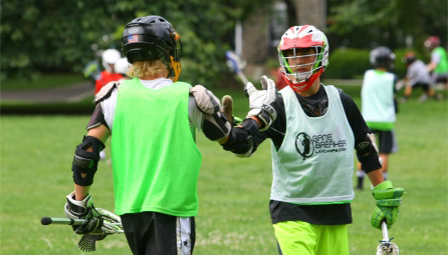Preparing for Lacrosse Camp

Our Top 5 Training Exercises to Begin Today
April showers bring May flowers, and Lacrosse Season! This is the time to brush the cobwebs off your equipment — and your body. If you’re currently on a school lacrosse team, it’s likely that this is the season you’ll begin training. Lacrosse coaches across the country want their players to get moving yearlong, because they know off-season training results in top performing players in-season. Stay ahead of the competition with these tried-and-true pre-season drills and exercises to prepare for Game Breaker Lacrosse Camp.
Pre-Season Prep for Lacrosse Summer Camp:
I advise lacrosse athletes to warm up with single leg squats on a chair, followed by walking on a wooden 2×4 and pivoting low. Create more challenging obstacles as you gain strength and confidence.
—Todd Murray, Expert Trainer & Owner of Results Plus Fitness
1. Leg Squats for Explosive Speed on the Field
Think lacrosse is all about launching a powerful pass or goal? Think again. A standard lacrosse field is 110 by 60 yards (approximately 100 x 55 meters). This means that midfielders, attackers, and defenders can rack up 4 to 5 miles of running in a single game. Offensive players use speed and endurance to evade defenders; defensive players need speed to cover the opposition, or throw accurate checks. A player’s mileage depends, of course, on playing time and overall activity on the field; however, there is no doubt that leg training is important if you want to outperform your opponents. For this reason, it’s important to supplement running drills with weight training. Focus on strengthening your legs to develop a powerful base and support explosive sprints. Squats are effective and don’t require a gym or elaborate equipment. Dumbbell squats also strengthen your core and help stabilize the micro muscles around your knees and ankles.
- Starting with 10-pound dumbbells held at your sides with palms facing your legs, keep your back straight, and place your feet shoulder-width apart.
- Lower your rear end as if you are about to sit in a chair. You want to get your thighs to be parallel with the floor, while keeping your chin up and back straight.
- Pause in the lowered position for a breath, and then push from your feet and squeeze your glutes to return to a standing position. Use a full-length mirror to check your posture to avoid injury, and never lower to the point that your thighs are no longer at a 90-degree angle to your calves.
- Work up to 3 sets of 6 to 10 repetitions, and increase weight only when you feel that 10 repetitions are no longer challenging.
2. Lunge for Longevity
Another great way to build leg strength and incorporate cardio is the walking lunge. Walking lunges are a little more difficult than basic lunges, but the added movement will also strengthen your core and stabilizers.
- Start with 5 to 10-pound dumbbells (or kettlebells) in each hand with palms facing your legs. Stand with your feet hip-width apart, and add a slight bend to your knees.
- Keep your eyes forward, so your neck remains neutral.
- Tighten your stomach, and take a step forward to land with your heel first.
- With your forward foot firmly gripping the ground, lower your hips until your back knee is 1-2 inches off the floor. Maintain your weight evenly over your entire front foot. The back foot will rest on the ball of your foot with your heel lifted.
- Keep your shoulders over your hips, and pause for a breath while your body is lowered.
- While keeping your chest high, use your front foot to evenly grip the ground and activate your glute and quad to push yourself to return to standing with legs returning to a hip-width position.
- Repeat with the next step forward. Work up to 3 sets of 10 to 15 repetitions on each side. Do not increase weight if you cannot maintain good technique.
If you are just getting started with seasonal strength training, start with stationary lunges, or one-leg stationary lunges with a weight bench or kitchen chair. Remember: injuries before the season are NOT allowed, so always practice good form and know your limits.
3. Monkey Around
Lacrosse Goals are attained not by strength but by perseverance.
—Felicity Luckey, author of Great Minds Think Fit
In addition to weight training, off-season conditioning drills will help you increase your speed and stamina. After your weight training sessions, get outside and try this easy drill:
- Space 4 cones, balls, or plastic party cups in a T-shape, with the markers approximately 10 yards apart
- Starting from the bottom of the T, sprint and crouch to touch the top middle marker
- Once you touch the first marker, sprint to touch the left marker
- After you touch the left marker, sprint to touch the right marker, then sprint back to the base of the T
- Remember to always maintain good form..
4. Sprint for Speed
In addition to weight training, off-season conditioning drills will help you increase your speed and stamina. After your weight training sessions, get outside and try this easy drill:
- Space 4 cones, balls, or plastic party cups in a T-shape, with the markers approximately 10 yards apart
- Starting from the bottom of the T, sprint and crouch to touch the top middle marker
- Once you touch the first marker, sprint to touch the left marker
- After you touch the left marker, sprint to touch the right marker, then sprint back to the base of the T
5. Shadow Shooting
Shadow shooting only requires a stick, and is a simple drill for solo practice at home. This drill is designed to improve your shooting technique, footwork, and speed by mimicking shooting mechanics without a ball. It also gets players to practice correct hip placement for accuracy in shooting.
- Grab 2 cones (or other markers) and a net (or box that is roughly the same width as a lacrosse net).
- Set up 1 cone as a starting point approximately 5 yards from your net. While facing the net, set up the second cone so it’s approximately 3 yards to the left of your first cone, and parallel to the net. This second cone will be your imaginary “opponent.”
- Starting at the first cone, face away from the net, and begin backpedaling towards the right side of your practice space until you are directly in front of the second cone.
- Plant your right foot and position your hips so they are square to your “opponent.”
- While continuing to face forward, back pedal as fast as possible to move back and across your goal.
- Continue this drill from left to right 5 times, and then begin from the right cone and practice moving backward over the goal from right to left.
Always make sure you’re moving your hips – not your shoulders. Feel free to enlist a friend to time your speed during this drill; however, speed should be secondary to correct form. This drill will help improve your awareness of where you are on the field without needing to take your eye off the other team’s players – and practice will help keep you from tripping over your own feet!
Do you have a favorite off-season exercise or practice drill? Leave a comment below to share a tip with your fellow lacrosse campers. Have you or your children expressed an interest in lacrosse? Are you looking to advance your lacrosse skills and prepare for college sports? Register now for Summer 2022, and foster a love for lacrosse. Learn more at Game Breaker Lacrosse Camp.



